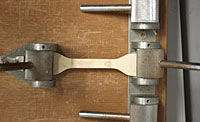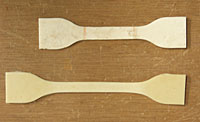Rubber Test(Plastic or synthetic rubber?)
Many types of plastic and synthetic rubber are available for a great number of uses. Both plastic and synthetic rubber are made from small particles and may be colored with some sort of dye. Vulcanization (adding sulfur), pressurization, and heating give these materials rubber-like characteristics (extensibility for stretching and restorability for contracting). For the purposes of customs duties, this material is classified as synthetic rubber, different from plastic.
[ By the naked eye: ]

Rubber

Plastic
Both look like particulate plastics.
[ Let's test a piece of rubber. ]
To verify the rubber-like characteristics, we add sulfur to a sample and apply pressure and heat to create rubber. Then, we test the rubber by a special test device.

Kneading a sample

The rubber is ready.
[ Let's test the tensile strength of some rubber. ]

Use the machine to pull on the prepared piece of rubber.

After being pulled by the machine, the rubber returned to this length. (Above: Original piece of rubber)
A material passing the above test is considered to be synthetic rubber.
- Electron Microscope(Aluminum oxide or artificial corundum?)
- DNA Analysis(Determining the species of tuna)
- Textile Analysis(Natural or chemical fiber?)
- Comonomer unit wt% Measurement (Copolymer or not?)
- Salt Analysis(Checking the elements in salt)
- Oil Analysis(What are the differences between gasoline, kerosene, and light oil?)
- Rubber Test(Plastic or synthetic rubber?)
![]()
Major Analytical Equipment: Introduction of equipment and devices used for analyses
